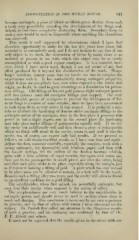Page 801 - My FlipBook
P. 801
FERMENTATION IN THE HUMAN MOUTH. 811
becomes antiseptic, a piece of bluish or bluish-green dentine from such
a tooth very powerfully retarding the development of the fungi^ and,
indeed, in two cases completely destroying them. Secondary decay in
such a case would be next to impossible where anything like cleanliness
was observed.
This result is well supported by observations which I have had
abundant opportunity to make for the last five years here where this
material is so extensively used, and I do not hesitate to say that if our
only object is to check the destruction of tissue by caries there is no
material at present in use with, which this object may be so surely
accomplished as with a good copper amalgam. It is a material, how-
ever, which I have never used, though I am not aware of any bad
effect produced by it beyond the discoloration of the tooth. Skogs-
berg's iodoform cement came into my hands too late to complete the
experiments with it. It has undoubtedly strong antiseptic properties,
which it does not completely lose even when exposed to the saliva, and
might, no doubt, be used to great advantage as a foundation for perma-
nent fillings. Old fillings of tin and gold possess slight antiseptic power,
still less (almost zero) old amalgam fillings (not copper). The very
inconsiderable power of amalgams to prevent the development of fer-
ment fungi is a source of some surprise, since we have been accustomed
to look upon them as very active in this r&spect. It is probably a mis-
take to attribute the hardening of dentine under amalgam fillings to the
antiseptic action of the amalgam, since in the first place it possesses this
power to but a slight degree, and in the second place the hai'dening
may take place under fillings of gutta-percha equally well. If we dry
the cavity but indifferently well and then choose a piece of gutta-percha
which we think will about fit the cavity, warm it, and stuti' it into the
cavity, we, of course, can expect only bad results. If we proceed as
follows, we will obtain excellent results, as I have seen time and again :
Adjust the dam, excavate carefully, especially the margins, wash with a
strong antiseptic, dry thoroughly with bibulous paper, and then with
the hot-air syringe, till the surface of the dentine becomes whitish,
paint with a thin solution of copal varnisli, dry again with warm air,
then put in the gutta-percha in small pieces, one after the other, being
sure that each piece sticks to its place, especially along the margin, just
as if you were making a filling of gold. A piece which has once moved
in its place must not be allowed to remain, as a leak will be the result.
Remove such a filling after two years, and the cavity will often be found
in an excellent condition for a gold filling.
The oxychlorides, when first mixed, are powerfully antiseptic, but
soon lose their energy when exposed to the action of saliva.
The oxyphosphates are very much inferior to the oxychlorides in
'
antiseptic power, and should never be used in cavities where there is
much soft dentine. This conclusion is borne out by my own experience
in practice, and by that of others with ^\•hom I have conversed on the
subject. Dr. Paetsch first called my attention to the disastrous results
of such a practice, and his testimony was confirmed by that of Dr.
F. P. Abbott and others.
It must not be expected that the results given in the above table are


